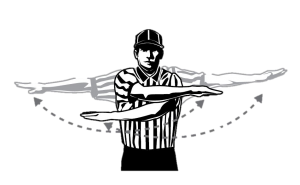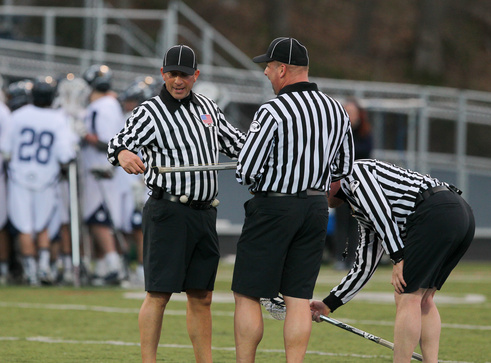 Most players, coaches, fans and often times new officials, do not completely understand what the somewhat ominous gathering of officials at midfield conducting a series of experiments on players sticks is all about. This post will address the requirements for a legal crosse, types of checks conducted, the mechanics of conducting a check, the types of fouls, how best to report them and lay out a philosophy how to assess any violations.
Most players, coaches, fans and often times new officials, do not completely understand what the somewhat ominous gathering of officials at midfield conducting a series of experiments on players sticks is all about. This post will address the requirements for a legal crosse, types of checks conducted, the mechanics of conducting a check, the types of fouls, how best to report them and lay out a philosophy how to assess any violations.
Under NFHS rules, officials are expected to perform at least two random equipment checks during a high school game. The goal of these checks is to ensure that players are properly and safely equipped and that the sticks do not give any one player an undue advantage. Illegal stick penalties are game changing fouls. By rule they are all 2-minute non-releasable and, as they are personal fouls, they count towards a player being disqualified. These are big fouls and you want to get them right.
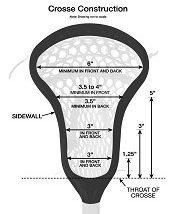 In 2017 the NFHS rules committee revised crosse dimensions and specifications to address issues with the ball becoming stuck in the crosse. These changes allow the ball to become dislodged more easily, create more active play and improved passing thus lessening the risk of slashes and cross checks which were being used to dislodge the ball. The changes also made crosse construction consistent with NCAA rules.
In 2017 the NFHS rules committee revised crosse dimensions and specifications to address issues with the ball becoming stuck in the crosse. These changes allow the ball to become dislodged more easily, create more active play and improved passing thus lessening the risk of slashes and cross checks which were being used to dislodge the ball. The changes also made crosse construction consistent with NCAA rules.
The Crosse
Rules 1:6 and 1:7 spell out what the legal dimensions and construction of a lacrosse stick.
The head at the widest point must be a minimum of 6″ wide, or 10″–12″ for a goalie stick.
The sidewall may not be more than 2″ high. Three additional measurements must be checked on a field players crosse: at 1.25″, 3″, and 5″ the width must be at least 3″.
If a ball stop is used it may not exceed .25” x 2” x 1.5” and a crosse may only have one ball stop.
The length of a short stick is between 40″–42″. A long pole is between 52″–72″. A goalie stick may be between 40″–72″. The shaft may not be cambered or bent. The circumference of handle may not exceed 3.5 inches. Adjustable-length handles are illegal.
Tape is allowed on the head of the crosse for anyone not taking a faceoff (Rule 4-3-3 n).
Tape ring exceeding 3.5″ in circumference located farther than 3 inches from the butt end of the crosse. All hollow shafts must have a end cap specifically manufactured for lacrosse.
The Pocket

The pocket of a non-goalkeeper crosse may not be deep enough for the top of the ball to be visible below the sidewall. There is no maximum depth requirement for the pocket of a goalkeeper’s crosse.
Pockets of nontraditional synthetic material manufactured for lacrosse are permitted. as long as the pocket meets the specifications of Rule 1-7.
No pocket may not have a hole, lip or hook in its mesh designed to ensnare. The use of pull strings to alter the depth of the pocket is illegal. All pockets may have only one sidewall string.
Shooting Strings
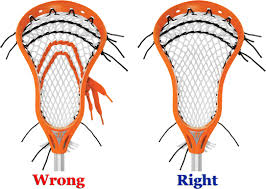 Shooting strings are horizontal threads that affect a player’s ability to hold the ball and affect the release point on passes and shots. These strings are usually not included when a player purchases a head, rather they are added later.
Shooting strings are horizontal threads that affect a player’s ability to hold the ball and affect the release point on passes and shots. These strings are usually not included when a player purchases a head, rather they are added later.
Any additional strings or laces (e.g., shooting strings, V channels) must be located within 4” of the top of the crosse. Any hanging strings or leathers may not be more than 2″ long.
When to Conduct a Check
Typically officials conduct one random check per team in the first half and one per team in the second half. Most checks occur during a team time-out, between quarters or immediately following a goal. A check requested by a coach is conducted during an official’s time-out. It is good practice to complete all required random checks before the fourth period. Under no circumstances are any checks allowed after the game has ended.
Pre-Game Checks
As a courtesy, officials make themselves available to both teams for check sticks prior to the beginning of the game. Sticks that are found to be illegal are not penalized as they game has not yet begun. Officials should position themselves on the far side of the field at the midline after the field has been inspected and the coin toss conducted.
Sticks that are found to be legal are not immune from being checked during the game as they may become illegal during play. It is good practice to tell players: “This stick is legal now.” Do not say: “This is good or legal” as you may check it again during the game. If you find a stick to be illegal explain the issue, the player may correct the problem. If it is border line, let them know or “This is close or tight.”
DO NOT check a stick if asked to do so by a player once the game has begun. Any check, during halftime or any illegal stick must be flagged!
Coaches Request
In addition to these random checks, a head coach may request an equipment check on a specific player at any time during the game (but not after the game has ended). The coach must identify the player by number. Each coach is allowed one free check per game. If the player’s equipment or crosse is illegal, the coach keeps his free check. However, if the equipment or crosse is found to be legal, the coach loses his free check. He may still request another check, but if everything is legal, his team is charged a timeout or is assessed a technical foul if no timeouts remain. (See NFHS Rule 4:27)
Note that a coach’s request for a stick check will often elicit passionate responses from the opposing coaches, players and fans. The request is completely legal, but in the eyes of many, a request by a coach, particularly on a faceoff crosse, is against the “unwritten rules” of lacrosse. Make sure that you and your crew maintain control of the situation. Most importantly remain calm and adjudicate the situation quickly and make sure everyone knows what is going on before you restart play.
Mechanics
In a two man game, the far side official should grab a ball and the bench side official should grab two sticks and inspect each players equipment. In a three man crew, the single side official should find the ball while the bench side officials each grab a stick from a player heading to the team they are in front of. In three man mechanics, the Single side official grabs a ball and the two bench side officials grab a crosse from the team they are in front of.
Who
Any stick in possession of a player may be checked and a player may be checked multiple times. It is not necessary to keep track of the numbers of the players inspected.
NEVER check a goalkeeper stick unless the opposing coach requests it.
An official should identify the player by his number and ask for his crosse. “Blue 34, please hand me your stick!” Ask that players not throw their crosse at you.
Be vigilant for players adjusting their crosse prior to, during or after the request! A player who pulls his pocket tighter and uses pull strings should be flagged. However, you will often see players punch their pocket. Note that this makes the pocket deeper and is not an attempt to avoid a flag. This action should not be flagged.
In addition to determining whether or not a stick is legal, officials need to check that players are wearing all of the required equipment (see Rule 1:9):
- Field player – Legal mouth guard, helmet, shoulder pads, arm pads, gloves, and cleats
- Goalkeeper – Legal mouth guard, helmet, throat guard, chest protector, gloves, and cleats
Don’t Look for Trouble
In my opinion, random equipment checks should not be done after a flag-down situation or when someone is already serving a time serving foul. You don’t want to pour gasoline on a fire.
During my pre-game with faceoff middies, I ask them to tell me they are a FOGO if any one of my crew requests their stick for a random check. That being said, I explain that if a coach requests that their stick be inspected, I will need to check it. Don’t look for trouble.
Where
Stick checks should be conducted away from the players and the bench area at midfield, unless checking sticks following a goal.

In two man, each official measures the crosse they have grabbed while in three man, the Umpire and Field Judge hold the crosses and face the benches, while the Referee conducts all the measurements. While the R is measuring one crosse, the U or FJ may conduct the roll out test and then hand the ball over to his partner.
Conducting the Check
There are a three tests that are performed on a crosse: the Pocket Test, The Roll Out Test and the Measurements. First, test the pocket depth. Then determine if the ball rolls out from the front, then measure the width of the head from the front, the length of the head and finally the length of the stick from the top of the head to the butt end. You do need to conduct these tests in any particular order. The official with the ball should start with the pocket and roll out test, while his partner measures a stick. They then switch.
An equipment check and stick check should take no more than 30 seconds to complete.
Pocket Test
Use ball to test pocket depth. If you can see the entire ball below the lowest part of the plastic sidewall the stick is illegal. Check to see if there is a ball stop. A ball stop is not required, but no more than one balls top may be used. The pocket may not have a lip or hook in it which ensnares the ball. (See Rule 1:6-7)
Roll Out Tests
 Roll the ball out by tipping the head of the crosse forward from a vertical position. Then roll the ball out each side of the cross by tipping the head of the crosse to either side from a horizontal position.
Roll the ball out by tipping the head of the crosse forward from a vertical position. Then roll the ball out each side of the cross by tipping the head of the crosse to either side from a horizontal position.
NFHS Rule 1:6 Article 2 adds an additional stick check procedure to ensure that the ball will roll out of the top end of the head. With the ball in the crosse at the deepest point of the pocket, horizontal to the ground, tip the crosse forward 90 degrees to ensure that the ball rolls out of the top end of the head.
DO NOT check to see if the ball rolls out of the back of the crosse!
Measurements
Measure the full length of the crosse from top of the head to the butt end.
- Short stick: 40-42 inches long
- Long stick: 50-72 inches long
- Goalie’s stick 40-72 inches long
Measure the inside edge of the head from the widest point.
- Must be at least 6 inches wide
- Goalie’s stick 10 to 12 inches
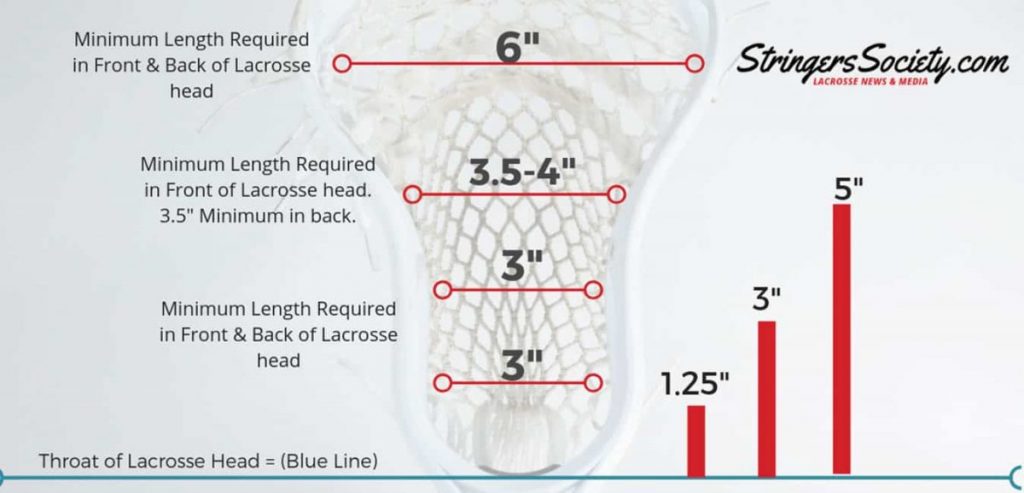 Measure the three lower points.
Measure the three lower points.
- at 1.25 inches from the throat of the crosse must be at least 3 inches
- at 3 inches from the throat of the crosse must be at least 3 inches
- at 5 inches from the throat of the crosse the width must be at least 3″
Measure the length of the head from the top of the plastic.
- Must be at least 10 inches long
- Goalie’s stick 10 to 12 inches long
If you have trouble remembering all of the measurements, write the numbers of a piece of tape and stick them on your tape measure. You can also mark a line with a sharpie on the important numbers on the tape itself.
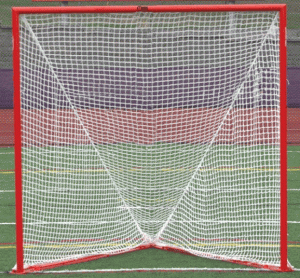 To speed the measurement of long poles, determine points on your body that corresponds to heights of roughly 52 inches and 72 inches. The crossbar of the goal is 72 inches above the ground, and may be used as a benchmark.
To speed the measurement of long poles, determine points on your body that corresponds to heights of roughly 52 inches and 72 inches. The crossbar of the goal is 72 inches above the ground, and may be used as a benchmark.
DO NOT measure the back of the head.
Get off and Fix Violations
There are a few equipment and crosse violations that are not penalized immediately. These are known as “Get off and fix” violations, and are taken care of by warning the player or the player’s coach about the violation and giving the player the opportunity to fix the violation, put on legal equipment, or switch out crosses.
- Strings hanging longer than 2 inches. (Rule 1:8 Situation)
- No manufactured end cap. (Rule 1:7 Art. 4)
- FOGOs may not have tape touching the plastic throat or head of their crosse (Rule 1:7 Art. 5)
- Tape ring more than 3 inches from the butt end. (Rule 1:6.1 Situation)
- Shaft of the crosse must be “relatively straight.” One that is bent is not legal and must be removed from the game and either fixed or replaces. (Rule 1:7 Art. 4)
Assessing Penalties
Illegal stick penalties are no longer tiered and now all sticks once fixed may return to the game. All illegal stick and deep pocket fouls are two-minutes non-releasable. A player may be assessed an additional one minute non-releasable foul for adjusting the crosse prior to inspection.
A player who adjusts the strings of his crosse or widens the head after the official has requested the crosse is flagged with a one minute non-releasable unsportsmanlike conduct penalty and the check continues. This penalty is added to any additional penalties assessed after the check is complete (Rule 5:5 Situation D).
It’s Good, It’s Close, Dang!
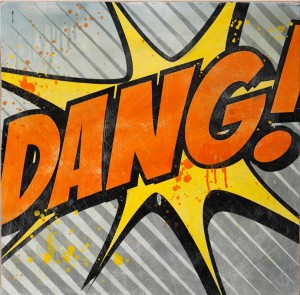 I have a general rule of thumb when it comes to measurements. First, determine if the ball freely roll out. Any stick where the ball does not freely roll out is clearly gaining an advantage. If the ball rolls out freely, move on to the measurements.
I have a general rule of thumb when it comes to measurements. First, determine if the ball freely roll out. Any stick where the ball does not freely roll out is clearly gaining an advantage. If the ball rolls out freely, move on to the measurements.
With measurements there are are three possible categories, or what I call the Collver Rule: Good, Close, and Dang!
If you cannot determine that the equipment or crosse is illegal then rule it legal. So any stick that is close, borderline measurements, give it the benefit of the doubt. Let the player know that it is close. A stick needs to be clearly illegal for me to rule it illegal.
Disallowing a Goal
If a player scores a goal and then is found to have a violation that specifically disallows a goal before the next live ball, the goal is taken off the score board.
- Deep Pocket
- Altered Stick
- Adjusted Prior to or During Request for Inspection (Rule 5:5 Situation E).
Any goal scored by the player prior to the violation being discovered stands. A goal scored by another player stands, even if they were involved in the play (e.g. the player who had the assist) or other illegal equipment does not disallow the goal.
Reporting Illegal Stick Penalties
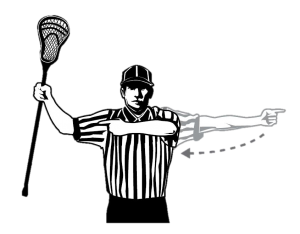 As these checks are done during dead balls, coaches and players will often be in their huddles and unaware of what is going on with the equipment checks. The Referee should get the attention of coaches, players and table personnel first and then throw the flag. Make sure that everyone is paying attention before you report the penalty.
As these checks are done during dead balls, coaches and players will often be in their huddles and unaware of what is going on with the equipment checks. The Referee should get the attention of coaches, players and table personnel first and then throw the flag. Make sure that everyone is paying attention before you report the penalty.
An official should explain what was illegal about the crosse. “Coach, it was too short.” “It is pinched.” “Coach the ball would not roll out.” But under no circumstances is an official to demonstrate what was illegal about the stick.
Take your time. These are big penalties and a number of issues pop up. The most important thing is that everyone understand what is happening.
Illegal equipment and illegal crosse penalties (Rule 5:5-6) are personal fouls and count towards a player being disqualified (fouling out) after receiving 5 minutes of personal foul time. Make sure you check with the scorekeeper to determine if anyone is disqualified.
 If both crosses are found to be illegal during a check, administer as simultaneous fouls in which sequence cannot be determined. Therefore for penalties of the same length, award ball with Alternate Possession. If the fouls are of different lengths, the team with the least amount of penalty time starts with possession (i.e. one minute illegal equipment NR vs 2 minute illegal crosse NR).
If both crosses are found to be illegal during a check, administer as simultaneous fouls in which sequence cannot be determined. Therefore for penalties of the same length, award ball with Alternate Possession. If the fouls are of different lengths, the team with the least amount of penalty time starts with possession (i.e. one minute illegal equipment NR vs 2 minute illegal crosse NR).
Play on!
Greg Hite
GLOA Trainer
Revised March 23, 2025

